fixing
- 1990s CNC Vertical Mill Revivalsalvagedcircuitry.com 1990s CNC Vertical Mill Revival | Salvaged Circuitry
The 1990s were home to manual tuning radios, Polaroid 600 film, Microsoft Bob and the never ending audible onslaught of manufactured boy bands - not necessarily reliable and easy to use CNC milling machines! This is a guide on how to make a very sad servo-drive, DOS 1.0 based, Intel 486 powered CNC ...
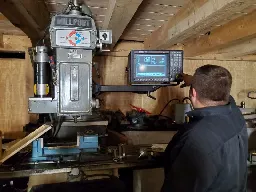
- Literature on repairing?
Hi,
Is there good literature on how to repair stuff? Just general things, not specific appliances. How to repair wood, how to properly sand wood and metal, how to replace a tile, how to read and analyze circuits, identify faulty parts and correct replacements, etc. I just want to become better at repairing stuff.
- Vehicle Repair
I do not know if these have been posted yet, but I thought I would share them just in case
- Car Complaints: https://www.carcomplaints.com/
- Motor Online: Vehicle Information Library: https://vil3.motor.com/LogIn.aspx
- Caliper Fixup

I bought this set of outside calipers at a junk store in my hometown (sort of a consignment, thrift store deal, with lots of old furniture, and the contents of like half a dozen garages right down to the old jars of mismatched screws. I sort of use it like a hardware store).
I like this design a lot, I like the lack of a spring on the jaws, and that you can fasten the little distance measuring arm to the side it measures on, so you can close the calipers around something, tighten that wing screw, then open the calipers to get them back.
They had some surface rust, so I decided to clean them up. The first step was to disassemble them. Not difficult when there's only three pieces involved.
I let them soak in some evaporust for about 8 hours. I really like this stuff, it hits the sweet spot between very effective and not especially dangerous, and it's reusable! They do overestimate how effective it is in their instructions though, so it often takes longer.
! The calipers, straight out of the evaporust. You can already see some text which was hidden before, along with the initials AM from a previous owner.
Now that the worst of the rust had been dissolved, it was time to switch from chemical to mechanical cleaning. I sanded it down with 400 grit emery cloth.
! The calipers with only one side sanded.
As I cleaned up the sides, I found a few neat bits of history:
! Here's some funny nicks up near the joint on one side. I wonder what caused them. And the previous owner's mark on the right side, AM. This is a big part of why I love old tools. I love the history they carry with them, even if I don't know all of it.
! Looking better, but still a ways to go. I was surprised to find that there weren't any markings on the little distance arm. I'd been expecting to find little angle tickmarks or something, maybe even printed numbers, but there weren't any to be seen after the evaporust, or once I started gently sanding off the remaining rust and the black crud evaporust leaves behind.
Once I had most of the rust gone, I switched to steel wool. I didn't want to take too much material off the surfaces, and I felt the more flexible steel wool would hit inside the pitting from the rust better.
The steel wool shined it up quite nicely. And here's a closeup of some of the surface pitting left over by the rust on the left side. The back of these calipers didn't have this kind of damage.
It was tempting to leave it here, but I didn't want the rust to return, so I decided to treat the calipers with cold blue, to provide some protection against oxidation. There are other ways to protect steel, but I like the look and it seems to hold up well enough.
Cold blue always looks a little rough when it first goes on (this stuff is a gel you don't want to get on your hands. You wipe it on, leave it to darken the metal for 60 seconds, and wipe it off again) but a little burnishing with 0000 steel wool will tidy it up:
There we go, still pretty shiny, but not as likely to rust again. Not bad considering how it looked in the beginning. Hope you'd approve, AM.
(I wrote this post for the making/fixing things blog I have on our local movim instance. If you're a slrpnk.net local, your credentials will work on movim automatically!)
- Kobo and iFixit partner for OEM parts and repair guideswww.theverge.com Kobo and iFixit partner for OEM parts and repair guides
Fixing them will require patience, but at least it’s doable now.

cross-posted from: https://feddit.cl/post/2652008
> Kobo and iFixit partner for OEM parts and repair guides
- Refrigerator leaking black liquid?

Refrigerator is a Frigidaire LTFR1832TF0.
Leak came from the front-right side.
I did not notice any temperature fluctuations, but I also don't notice much of anything. It still seemed cold when I unplugged it, though!
Checked the drain pan & it seems dry? Not overflowing or anything.
No water on inside of refrigerator.
Anyone have any idea what might be going on? I'd really appreciate it, as no one can take a look for another 3 days.
I don't want my food to spoil, as I don't have a lot of money. I just want to know if it'd be safe to plug it back in!
Thank you.
EDIT: had my BIL stop by to take a look. More than likely it's refrigerant. The compressor was fine, but one of the lines on it would not get cold, so that's that. Probably a leak in the line, more than likely from a failed seal.
The cost to refill the refrigerant / repair the line / seal would cost waaaaay more than a new fridge, unfortunately.
Thanks, y'all. Appreciate the help and advice.
- Quick Shed Door Repairmovim.slrpnk.net Blog • Quick Shed Door Repair
This was a pretty quick little project - some of my friends recently bought a house, it came with…

This was a pretty quick little project - some of my friends recently bought a house, it came with a shed, and the door of that shed was broken. The design of the door allowed it to swing open about 180 degrees, at which point it'd hit its own frame.The wind must have caught it one day and swung it open hard. When that big wide door hit the frame so close to its fulcrum, it just snapped right down the line. It also bent all the hinges.
The previous owners tried to fix it, it looks like by lifting the door back in place and driving some mismatched screws through some wood scraps and metal plates. That left the door drooping, hanging crooked in the frame, and flexing kind of alarmingly when it opened.
We'd talked about taking it down and fixing it properly, I even took some measurements.
Then one morning I got lucky, I saw a post on our local Buy Nothing -type page where someone was offering up some 1"x12" boards they'd been using as shelves in a shed. They were a bit weathered but otherwise in good shape (no cracks, warp, or rot). It was trash day in that neighborhood so I hustled out there and claimed the whole pile. 1"x12"s ain't cheap.
On the way back I picked up a shovel with a cracked handle which I fixed with a hose clamp and have been using for a couple years now.
We set a day, I packed the lumber and tools, and we started in on the shed. I think we also planted a peach tree (using my new shovel) that day.
We started by taking the door off the shed and setting it on some sawhorses I brought.
! (Dog helping hold down the door)
This was where we made our first unfortunate discovery. The shed was older than we'd realized. The 1"x12"s the door had been made from were rough cut, not dimensional, so the boards I'd brought were about half an inch narrower, and a quarter inch thinner than the originals.
So we had a couple options here - all the boards were rotten for a few inches of the bottom. We could replace all of them with the new ones, which would be a close fit of all our materials, and would lose us a couple inches of width unless we added another board, or we could save lumber all around and change the design to keep most of the existing door but make it a little janky. They were good with that, so we did a kind of strange design.
First we removed the split board and it's support scraps and set them aside. Then we cut one of the new boards to the original/final height of the door.
Next we measured far enough up to catch all the rot, and we cut the door that much shorter.
We attached the new vertical board so it extended a couple inches at the top and bottom (it's on the right in the picture above). Then we added two braces across the face of the door, so they went across at the final height of the door/the long new board, leaving a bit of space above and below the old boards. These would add some extra ridigidity, by having pieces going across on the front and the back, and they'd hide the difference in length. Then we cut some pieces to go behind them, fitting flush above and below the old boards. These weren't structural, they just took up space so critters and weather wouldn't get in.
Once the door was made, we started looking at hanging it again.
Unfortunate discovery two: the doorway was crooked. Part of that was the fault of the badly rotted board which crossed the doorway under the door. It didn't seem to be doing anything but catching rain and soaking it up, so we pried it off and replaced it. Luckily it only crossed the doorway, it wasn't actually part of the building frame, which seemed to be in okay shape. The top of the doorway was also out of square, but not enough to be a major problem. As they reminded me a few times, it's a shed, not a house.
We straightened out the hinges by putting them on a brick and pounding on the high points with a small sledge (not ideal but it worked). Then we hung them back up and attached the door. From what I remember, it sat just above the new lower plate when it was closed, might have rested on it but I don't remember.
The last step was to cut a thin piece to attach to the inside of the door frame to make up for the width lost by replacing a roughcut board with dimensional.
From there, I think we called it good. It had rained on and off during the project, and we didn't want to re-attach the trim while it was wet for fear of trapping water between the boards.
We cleaned up the tools and had some pizza.
As a side project, I took the original, very rotted wooden door handle, and the scraps of the split board. From the dimensions of the original and the look of the wood, I figured they cut the original from scraps of the same roughcut 1x12s they built the rest of the shed out of, so I wanted to make the replacement the same way.
I traced the original onto the wood, flipped it end for end, and traced it again, and sort of averaged the two. The original wasn't actually symmetrical but my replacement would be much closer. Then I started sanding it down until it was comfortable to hold. I pre-drilled the holes for the screws, including space for the heads, so they wouldn't split the handle when it was attached.
I stained it, I think my usual mix of Gunstock and Red Oak, then applied a few coats of urethane, sanding lightly between coats. I even got the back, where it'd touch the door, and the holes for the screws. I figured they could paint it whatever color they painted the door, like the original, or leave it as-is, either way it'd be very waterproof and last a long long time.
All it needs now is a new coat of paint.
- Fairphone 5 schematics, repair, and recycling documentation is now availableliliputing.com Fairphone 5 schematics, repair, and recycling documentation is now available - Liliputing
Fairphone 5 schematics, repair, and recycling documentation is now available
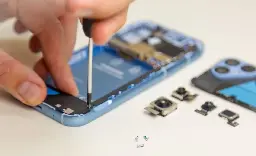
I am quite happy so far with my FP5. But I am looking forward to the upcoming Ubuntu Touch and Mobian ports.
- Fabricating a replacement insert for a Delta 36250 Miter Sawimgur.com Replacement insert for a Delta 36250 - Album on Imgur
Discover topics like tools, yihp5k wboxrncycrwwyia, repair, and the magic of the internet at Imgur, a community powered entertainment destination. Lift your spirits with funny jokes, trending memes, entertaining gifs, inspiring stories, viral videos, and so much more from users like jacobcoffinwrite...
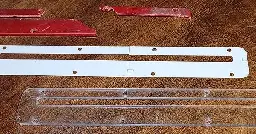
Once you get access to a laser cutter, you start to see all kinds of places you can use it in a project. Our local makerspace has one, and the more I use it, the more I find new applications, whether that’s in fabrication of flat parts, or just adding flair to smaller panels of a large project.
Around Christmas, I decided I was going to fix up my dad’s miter saw. It was an older, discontinued Delta 36250. The guard was missing(my grandfather didn’t believe in tools having guards) and the plastic insert in the table, where the saw blade came down, had been shattered for years.
The guard was an easy fix, bought a replacement part from ereplacementparts. But the plastic inserts were out of stock. In fact, even the scam parts websites that all look identical weren’t bold enough to lie and claim to have any of these things. Having examined what was left of the original, here’s my theory for why:
They’re junk. The space they fill is 5mm deep, but they were made to be cast out of plastic about 2mm thick with a lip around the edge to fill in the space. That plastic was super brittle. And then,just to make things better, the slot in the plastic, where the saw blade would go when it cut through the wood, wasn’t wide enough to accommodate the blade when it was rotated to do cuts at a 45 degree angle. Which it was designed to do. So the blade would come down through the wood, hit the brittle plastic at the wrong speed and blade type for cutting plastic, and shatter it. The inventories were out of stock because everyone broke theirs and ordered new ones, and they weren’t worth making in the first place
The obvious answer was to cut something close enough out of plywood and call it a day, but I wanted to get fancy with it. So I took some pictures, removed all the screws, claimed all the shards of plastic, measured the space, and brought the pieces home. Luckily enough pieces of the insert remained to get every measurement except overall length (which I measured while I was there). I used my calipers to get the original slot width, positions of the screw holes, etc. I drew up a vector image with my best guess at the final dimensions, and widened the slot until it slightly exceeded the damage marks from when the saw cut into it at a 45.
To get the curve at the corners I scanned in one of the shards, pasted it into the schematic in inkscape, and adjusted the rounded corners setting on the rectangle until it matched the scan.
On our makerspace night I cut a few cardstock templates, chased the screw holes around the design until they lined up with my plastic shards. And because I like adding some decorative aspect to practical items, I also drew up and cut a stencil of the name of his old military unit surrounded by a hawser rope.
This is one of the places the laser cutter really shines. When I was doing spray paint stencils in the past, I always cut them by hand with a scalpel blade(ironically cheaper than xacto knife blades). But this is tedious, takes forever, and certain designs really don’t lend themselves to it, so you find yourself spending lots of time gluing your bridges back together as they tear or bend. With the laser cutter, I had a template literally in minutes, and at least as precise as I could have done it. Some folks feel the art looses something when you make it easy that way, I’m personally more about results, especially when I’m on a timeline.
The makerspace didn’t have any plexi in the thickness I needed for the insert, so I reached out to TAP plastics for a recommendation. They had 4.5mm High Impact Modified plexiglass which they’d ship in custom dimensions, so I could get something small enough to fit inside the cutter. I went ahead and ordered that, and about a week later I had it. Enough material for four tries.
We ran the first cut slow in order to cut the thicker-than-usual plexi. That ended up melting it a bit along the edges and at the holes, so we did the second in two passes. I also redesigned the vector with smaller holes, and sent it again. This one came out better dimensionally, but the cutting fogged the plexiglass (it was the kind protected by sheets of plastic rather than paper, so we had to remove the stuff before running it in the laser). This wouldn’t be a problem except that I was planning to stencil the art onto the back of the plexiglass, so it would look deep and glossy, and would be protected by the plastic itself.
I covered the remaining material in painter’s tape and ran it again. The third one came out great, and I took them home for finishing.
The next step was to chamfer the screw holes on the drill press.This would let the heads of the screws sink down into the plastic where they’d be out of the way of boards sliding across the worktable.
Once I had that done, I peeled the painter’s tape off the back,and for once managed to remember to double check that it was actually the back and oriented correctly and everything. Then I attached the stencil so it was mirrored. I normally use temporary spray adhesive where I can to fasten the stencil down, to minimize the underspray. But a reverse stencil means any glue residue would end up between the plastic and the next coat of paint, so I had to skip it and just use stencil spiders (little metal weights, usually nuts, with paperclip/wire legs, which help you pin down high points).
I got very lucky, the paint went on well and didn’t leave me with any spots I had a problem with. I gave it a couple days to dry before messing with the stencil (this was good graff artist paint, but I’ve had the cheap stuff dry tacky, then when you try to lift the stencil, the paint stretches, snaps, falls onto the work and bonds there. I didn’t think that would happen with this stuff but I wanted to be really sure). Waiting to find out if it came out okay is the worst part, for me.
When that was dry I checked it over, and painted on the background color.
By that point, I was out of time to check it for fit, so I wrapped it and waited until Christmas to find out if it would fit. Later that day, we tested it, and it was overall pretty good - I had to chamfer the holes a bit deeper on his drill press, and used a thin round file to adjust a couple of them just a touch outwards from the center. But it fit and looked quite nice overall. My vector file isn’t perfect, but I’m providing it on my website just in case anyone out there has a compatible saw and also access to a laser cutter, and for some reason wants to follow me down his road.
The saw file is available here as a pdf: https://jacobcoffinwrites.files.wordpress.com/2024/01/saw-insert-great.pdf (apparently wordpress won't host SVG files.)
And here as both pdf and svg: https://mega.nz/folder/CdMwVDQa#yiHp5k_WbOxrNcYCRwWyiA
(Sorry not to show the stencil, I realized partway through writing this that my dad wouldn't appreciate it if I did, but I still like talking about the stencil art process.)
- there’s another fix-it community
Note these two communities are essentially the same:
Mods might want to mention the other community in the sidebar as a related community. Note ATM both communities are on respectable proper decentralized nodes (e.g. neither are on Cloudflare).
- Austrian government launches repair scheme for electronic goodswww.bbc.co.uk Austrian government launches repair scheme for electronic goods
The Repair Bonus voucher scheme gives people cash towards repairing their electronic goods.
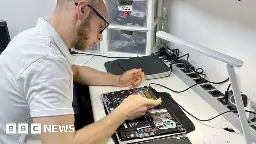
- Dieselgate, but for trains – some heavyweight hardware hackingbadcyber.com Dieselgate, but for trains – some heavyweight hardware hacking
[this is an English translation of the original article in Polish, we occasionally publish the best cyber stories from Poland in English] A train manufactured by a Polish company suddenly broke down during maintenance. The experts

This article is about fixing, but with a twist - it's about fixing trains that their manufacturer sabotaged. :D
In Poland, it took the hacker crew "Dragon Sector" months of work to find a software "time bomb" that was sabotaging "Impuls" trains manufactured by Newag, once their maintenance was handed over to another company.
Let this be a reminder to everyone about closed source technology and critical infrastructure.
- I fixed my toothbrush (fuck you, Philips Sonicare!)
Batteries died. It was a puzzle to disassemble it. It was booby-trapped with fragile self-destructing mechanisms like hair-thin wires ready to snap wrapped around the battery which had welded tabs soldered to wires. Requires surgical delicacy but at the same time lots of force to pry 3 plastic clips simultaneously while pulling off an inner casing using 2 hands on a task that needs 4 hands. Had to buy rechargeable batteries with tabs welded on where the tabs were not oriented in the direction the device was designed for so in one joint I had to put the soldering iron directly on the battery terminal. The battery pair costed 1¼ big macs because tabbed nippleless batteries are not a competitive market and only sold at retail prices. A new toothbrush probably would have had the same price but then I would have been suckering into giving them what they want.
I was able to do the job without breakage and it works. I was lucky the soldering heat did not destroy the costly battery. So I would like to send a very big fuck you to #Philips who tried to force me to buy another toothbrush, which I bought before I started boycotting Philips due to their shavers having the same disrespect for a #rightToRepair.
UPDATE
Just checked my records and see that I paid the equivalent of 4 Big Macs (today’s price) back in Jan. 2015. So the original batteries lasted ~8¾ years. Thus the batteries are indeed cheaper. I chose this model because it supports both 120v & 240v which I think is rare with induction charged toothbrushes.
Making a spot welder
Note that instead of buying batteries with tabs, I could have built a spot welder to put tabs on myself which would mean being able to buy any cheap batteries (which is half tempting because I am a cheap bastard). You basically keep an eye out for microwave ovens that people have trashed and cannabalize the transformer which can then be used to make a spot welder. Maybe I’ll do that next time.
Better toothbrushes
There is a toothbrush that takes normal AA batteries (which I keep at my folks’ house). It obviously avoids the problem of permanent batteries. But it has no charging system so the batteries have to be removed periodically for recharging. The bottom cap is very tight fitting plastic over a rubber o-ring which eventually cracked after so many times opening. If the cap had been metal it would have been the perfect toothbrush. One benefit is that it works worldwide.
- Is there any use of an end-of-life LED lightbulb?

I have a LED lightbulb that starts to flicker. Is there anyway to fix it, or any parts of it that could be useful for other uses(i.e. diodes for use in electrical circuits)?
Correction: After checking the product serial number carefully it is a fluorescent lightbulb as many pointed out. Thanks for the correction and advice.
(PS I am renting a house now so the type of lightbulb is of my landlord's choice. Obviously were I to choose I would rather have a LED lightbulb)
- Crosspost: I turned a dress into a cowl sweater: A smol blogpost
cross-posted from: https://slrpnk.net/post/3170240
> (view this in gemini too! gemini://okasen.smol.pub/how-a-dress-becomes-a-sweater) > > I just want to share this sweater DIY project I did last night in a furious anger at fast fashion. If anyone wants specific construction details, I can try to provide answers to questions! But in general, it was very slapdash and haphazard and I don't recommend anyone just jump straight into turning one piece of clothing into an entirely other piece. It takes a lot of practice and... battle-hardenedness... to not give up or be too perfectionist with this kinda stuff. So if you're already a sewist, give something like this a go! If you're not a sewist: become one!
- Reviving An Old Lime-E Beta Rideshare E-Bicyclehackaday.com Reviving An Old Lime-E Beta Rideshare E-Bicycle
What do you do when you come across a cheap electric bicycle on Facebook Marketplace from a seller who has a few hundred of the same ones available? If you’re someone like [Max Helmetag], you…
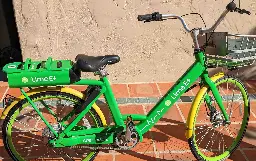
- E-Bike Industry Blames Consumers For Fires In Effort To Undermine ‘Right To Repair’ Lawswww.techdirt.com E-Bike Industry Blames Consumers For Fires In Effort To Undermine ‘Right To Repair’ Laws
Countless companies and industries enjoy making up scary stories when it comes to justifying their opposition to making it easier to repair your own tech. Apple claims that empowering consumers and…

- Mending jeans with Sashiko guidetamayandme.com Sashiko - '刺し子’
Step-by-step explanations how to fix a garment using Sashiko and Japanese techniques. This blog features two Sashiko techniques (one explained and one in a step-by-step video)

cross-posted from: https://slrpnk.net/post/1744045
> >Step-by-step explanations how to fix a garment using Sashiko and Japanese techniques. This blog features two Sashiko techniques (one explained and one in a step-by-step video)
- Arcade Cabinet Recovery and Restorations
Arcade cabinets aren't very solarpunk. They were huge items, heavy particle board, plastic, metal and glass and electronics, meant to be used for a couple of years and thrown away. For most of the golden age of arcade gaming, cabs were a bespoke arrangement, each one designed custom for their specific game, so when a particular model failed to sell as well as anticipated, brand new units were often dumped in a landfill rather than repurposed.
Just the same, I want to share a blog about arcade cabinet restoration (and also arcade history etc). Here's why:
Something brushes against solarpunk, I think, in the way the collectors of arcade cabinets treat them, like the technology is a precious natural resource, discovered in old barns and garages and warehouses, carefully recovered and conserved. Still put to use, but carefully, with the intent to pass them on to the next person.
Parts are traded around, broken machines carefully fixed. Favors traded. Even cabinets destroyed by water damage or mold are often picked over for parts, for the components are part of a small and ever-dwindling supply with no modern, (or at least authentic) replacements to be had.
I think they treat this technology the way I wish everyone else would, and how I think people in solarpunk fiction, which sometimes takes place in postapocalyptic settings where society is rebuilding more carefully, might treat the working remainders of a more wasteful society.
(They're helped of course in that technology was simpler for arcade gaming's run from the 60's through the 80's. Big chunky components, simple single layer boards, something a knowledgeable person with a multimeter and soldering iron could fix. I think there are some areas (certainly not computing) where I wouldn't mind seeing a return to simpler designs. Why is there a multi layer PCB with in-built components in my blender that works the same way as my grandparents'? But we'll need more of a fixing culture for there to be any real benefit to that.)
This blog goes into the history of arcades and gaming, but it also chronicals 'raids' where collectors work together to recover recently -rediscovered, often abandoned arcade cabinets and the writer's personal arcade cabinet restoration projects.
If you like seeing old stuff fixed up, especially around both electronics and furniture, I definitely recommend this.
- Reverse Engineering a ThinkPad Battery - And making a Perfect Clone
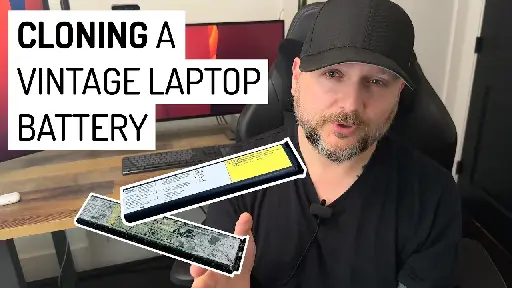
YouTube Video
Click to view this content.
- Kitchen Knife Handle Replacementimgur.com Kitchen Knife Handle Replacement
Discover topics like woodworking, diy, woodturning, and the magic of the internet at Imgur, a community powered entertainment destination. Lift your spirits with funny jokes, trending memes, entertaining gifs, inspiring stories, viral videos, and so much more from users like jacobcoffinwrites.
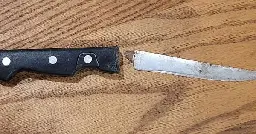
I had two basic farberware kitchen knives break in the same way. Both blades had the tang snap back inside the handle. Gluing it back in the grip didn't work, so I set them aside for a bit.
I have been fixing broken kitchen tools lately, so I decided to replace the handles for both knives.
I started by grinding a new tang into the knife blade. I had to shorten the blade of the knife to do this but my favorite kitchen knives are short, so I don't think I'll mind.
Next I turned the first handle on the lathe. I started with a piece of an oak branch I collected after a storm broke it off a tree in a local park three years ago. Several large (up to 8" diameter) branches came down, and the city took their time in cleaning it up. It was good hardwood that would have just been chipped anyways, so we decided to save them some person-hours and gas and went down with a hand saw one night, cut the branches into manageable pieces, and carried most of it home.
Once we got it home, I sealed the ends with wax and stripped the bark with a draw knife so it could dry in the basement. The slow (1 year per inch of material is what I've read) drying process seemed impractical at the time but I barely noticed it, getting distracted with other projects.
For these knives and the rubber scraper, I used the smallest of the branches we took.
I When it was ready, I removed it from the lathe, cut away the scrap on either end, sanded either end through all the same grits of sandpaper I used while it was on the lathe, and drilled/cut the slot for the tang.
The second handle took much longer to make - turns out it's harder to duplicate the dimensions of an existing piece than it is just winging it. That said, there's a noticeable difference in quality just between these two, so I'm learning as I go at least.
Like the first, I removed it from the lathe and cut away the extra material, and sanded both ends through all the grits of sandpaper I used on the piece while it was on the lathe.
I ground a matching tang into the second blade, drilled and cut the slot into the top of the second handle, and put them together for a test fit.
All in all, I was pleased with the result. The blades fit very tightly, and the handles looked and felt nice enough. The next step was to stain them.
I went for something a little different this time. I coated both with rustoleum black cherry stain I found on trash day, and noticed that certain parts of the wood came through much more red than the purple-brown color of the stain elsewhere. So when I did the second coat, I doubled down on that and used sedona red on the red parts and black cherry on the purple parts, all in the same coat, let them soak in, wiped them down, and let them dry.
I then touched it up with dabs of Red Oak stain and two sharpies, purple and brown.
I finished both handles with two coats of high gloss polyurethane. Once they were dry, I scored each blade on the tang near the end (I wanted a way the glue could grip it better, but found I couldn't drill through these with my metal bits and only the cutting wheel on the dremel would mark them.) They were already a tight fit, but I wanted to be sure they wouldn't slip out. Then I glued the blades in place.
I'm still very much an amateur at turning, and am learning as I go, but I've always preferred to learn by just doing a project, so getting these broken (fairly cheap) kitchen knives usable enough to return to the kitchen seemed like a good way to practice turning and finishing, and overall I'm pleased with the result.
- Show ‘Em What You’re Made Of With This Repair Logohackaday.com Show ‘Em What You’re Made Of With This Repair Logo
The only thing better than getting your hands on a repairable piece of hardware is actually finding the thing in the first place, which is why we love this “official” repair logo create…

- Rubber Scraper/Spatula handle replacementimgur.com Rubber Scraper/Spatula Repair
Discover topics like woodworking, woodturning, and the magic of the internet at Imgur, a community powered entertainment destination. Lift your spirits with funny jokes, trending memes, entertaining gifs, inspiring stories, viral videos, and so much more from users like jacobcoffinwrites.
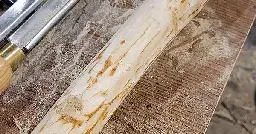
For the last few years I've been keeping the parts of any tools or kitchen implements that break with the intent to fix them. We had a rubber scraper/rubber spatula that snapped where the plastic handle thinned to fit inside the rubber head. The actual spatula part was still good, so I turned a new handle for it.
I started with a piece of an oak branch I collected after a storm broke it off a tree in a local park three years ago. Several large (up to 8" diameter) branches came down, and the city took their time in cleaning it up. It was good hardwood that would have just been chipped anyways, so we decided to save them some person-hours and gas and went down with a hand saw one night, cut the branches into manageable pieces, and hauled most of it home.
Once we got it home, I waxed the ends and stripped the bark with a draw knife so it could dry in the basement. The slow (1 year per inch of material is what I've read) drying process seemed impractical at the time but I barely noticed it, getting distracted with other projects.
I cut a piece of one of the smaller dried lengths of oak, and turned it on the lathe until it was similar to the original in dimensions. To be honest, it's a bit more chunky than I'd prefer, but considering that the original plastic handle broke, making the replacement sturdy is probably a good idea.
Then I cut off the extra material on either end and carved it down so it would fit the head of the rubber scraper. It's not centered vertically because the scraper was the same thickness as the end of the handle, but the rectangular hole was closer to the back than the front.
This also lined that part up with the heartwood of the branch, which seems like it should help with reinforcing it.
I stained it with two coats of stain, applying the second one while the first was still wet and rubbing it down so there was no extra. The first coat was gunstock (a bright, orange stain) and the second coat was red oak (a darker brown). Then I applied high gloss polyurethane, sanded it lightly, and applied a second coat.
For no extra materials, it's back in use in our kitchen.
- How to fix a book
Before I switched to Lemmy, I noticed a lot of questions on r/bookbinding about repairing books. So; I thought I'd create a list of repair guides that, to my knowledge, follow best practices.
Please note, if a book is particularly valuable or has historical significance, you should take it to a professional. Also, if your library book is damaged, you can return it as-is and the library will handle the repair. In either case, wet books should be frozen.
That said, here's how to repair:
Loose hinges:
- https://www.youtube.com/watch?v=EpUU4dwPzWA
- https://www.youtube.com/watch?v=fhyO8ptZAgI
Cracked hinge:
- https://www.youtube.com/watch?v=XK9Aqqns56E
Detatched hinge:
- https://www.youtube.com/watch?v=5w3BayjJ1rU
Detatched text block (recase):
- https://www.youtube.com/watch?v=C6eH8eb6daw
- https://www.youtube.com/watch?v=lm4Zt9Yh5xA
- https://www.youtube.com/watch?v=2z4sIj6go5U
Warped hard cover:
- https://www.youtube.com/watch?v=Dn-13BopXq4
Spine replacement:
- https://www.youtube.com/watch?v=OAaig_rKS5g
- https://www.youtube.com/watch?v=vNWHhuSnk5Y
Torn paper:
- https://www.youtube.com/watch?v=CBwT97IztS8
- https://www.youtube.com/watch?v=V0d-VvDcg_M
- https://www.youtube.com/watch?v=dWBwOYRCHdE
Torn out piece of a page:
- https://www.youtube.com/watch?v=lwTNVsi_HBg
Loose page:
- https://www.youtube.com/watch?v=xvTK8tUCcmA
- https://www.youtube.com/watch?v=P5Sq2jflWHM
Harcover corner repair:
- https://www.youtube.com/watch?v=BWL-swOol-8
Wet book:
- https://www.youtube.com/watch?v=S9_fwmdCyzo
- https://www.youtube.com/playlist?list=PLA2CAC9141448B159
Mold:
- https://www.youtube.com/watch?v=w_KdBP_fM4Q
Warped paperback spine:
- https://www.youtube.com/watch?v=EgLRFsGHzkg
Detatched paperback case:
- https://www.youtube.com/watch?v=jWR2JmsbMm0
More damage than that? Here's some more extensive repairs:
Rebind:
- https://www.youtube.com/watch?v=xkEC56T7Qlo
Paperback rebind:
- https://www.youtube.com/watch?v=iByMBvpFTNk
Paperback to hardcover recase:
- https://www.youtube.com/watch?v=IWTANgmtpfQ
- Serving Knife Repairimgur.com Serving Knife Repair
Discover topics like woodworking, woodturning, and the magic of the internet at Imgur, a community powered entertainment destination. Lift your spirits with funny jokes, trending memes, entertaining gifs, inspiring stories, viral videos, and so much more from users like jacobcoffinwrites.
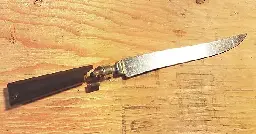
This is a bit simpler than some projects, and I think it would fit https://slrpnk.net/c/zerowaste just as well, but I think it’s nice to show the chance to fix even simple tools that break. I’ve got a few kitchen tools (other knives and a broken rubber scraper) that I plan to fix next.
A few years ago my grandmother threw a party, and someone dropped this knife on the floor. The handle was some kind of resin-plastic and it shattered near the top. She was going to throw it away but I said I'd make a new handle for it (it wasn't until I went looking for this picture that I realized I'd said that five years ago you guys jeez!).
I started by taking handle the rest of the way apart and breaking up some old glue, so I could separate just the blade and it's decorations from the broken plastic.
Then I started on a replacement handle. I cut this piece of pine from the trunk of our 2020 Christmas tree after it had had awhile to dry. It was the same piece I carved most of the koroks from: https://imgur.com/gallery/5zErlHt I'm still very much an amateur at turning, and made some mistakes as I went, but I learned a lot on this one, and was able to get some results I was pleased with.
I cut the top to fit the little decorative cap, drilled a line of holes for the tang of the blade, and did some test fits and adjustments.
I wanted the stain to be a reminder of the original maroon handle, so I started with gunstock (a very bright, orange-red color) and then while it was still wet, I worked in Red Oak, which is darker and more brown. This deepened it and brought out some nice detail in the grain. The red oak on its own turned the test pieces very dark brown, and wasn't as visually interesting, so I'm glad I did it this way. I followed that up with four coats of high-gloss polyurethane, with some light sanding in between. The pine was thirsty - drank up the urethane in some spots on the first coats so you wouldn't think any had been applied. Eventually I got a nice, even finish. I'm glad I finally got this done and I'm looking forward to returning it.
- Mending/repairing...Shoes/boots?
Sort of posting here with the odd hope of drawing some eyes to this space, and because, uh...I'd really be interested in if anyone that sees this may have insights into fixing up shoes and boots.
I'd make a distinct community for the subject but I have zero knowledge of the matter, and I'd post elsewhere, but their communities are more specifically focused (e.g. tech/automobiles/etc.).
Any sort of insight/advice from say, patching holes or rejoining the upper part to the bottom (blanking on the right terms here) or whathaveyou.
- Lathe Restorationimgur.com Lathe Restoration
Discover topics like restoration, tools, and the magic of the internet at Imgur, a community powered entertainment destination. Lift your spirits with funny jokes, trending memes, entertaining gifs, inspiring stories, viral videos, and so much more from users like jacobcoffinwrites.
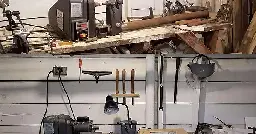
This was a more recent project. This lathe belonged to my brother’s girlfriend’s family. They were looking to get rid of it, and knew I had a workshop, so they offered it to me. (I accepted it sight unseen, as the description was vague enough that I honestly wasn’t sure if it was for wood or metal – worst case, I didn’t have a wood lathe yet, but you don’t pass up on the chance to get a metalworking lathe for free!)
It turned out to be a pretty basic Craftsman monopole wood lathe from the 80s. Most of the discussion I’ve found about these said that they were okay at best, fine to learn on but not worth spending much money to buy when there were better designs available out there.
It had been stored somewhere damp and had gotten pretty rusty, and the risk seemed low, so I decided to make a project out of it and learn some tool restoration skills. It ran as-is, but leaving tools rusty always felt kind of disrespectful to me.
I started by disassembling it, which took some doing and a lot of PB Blaster (once WD failed). I treated a couple of the little levers with white vinegar before reading that that was bad for the steel and the galvanized coatings, so I switched to evaporust, which I like a lot. You can save the stuff and reuse it, again and again, until it stops working (and even then it’ll work as degreaser).
All the small parts I dunked in a small bucket of evaporust, but the pole I had to wrap in paper towels soaked in evaporust and then with plastic so it wouldn’t dry. This stripped most of the rust but left a blackish crud that I had to scrape away with steel wool.
On metalworking tools, it’s common to protect them by coating them in oil, but I was advised that sawdust and oil aren’t a good mix, that the grease will collect sawdust and form a kind of cement-like crust as it dries. Considering the options I saw on tool repair forums, I chose two different ways to protect the cleaned parts. The little loose levers, bolts, screws, and threaded parts I treated with cold blue (often used to touch up scratches on guns) and on the monopole I used Johnson's paste wax, which is a floor wax that a lot of woodworkers apparently swear by.
The final result was pretty nice, I think. Between the coatings and the furnace keeping the workshop nice and dry, I haven’t seen the rust return.
- Using LineageOS to keep phones and tablets running after official support has ended
When my phone abruptly died a year ago, I stumbled into the world of degoogling and alternative ROMs for android devices while researching my options. Due to a lack of devices to try it on (so far, I’ve used each phone until it completely gave out) I haven’t messed with this yet, but I love the concept and wanted to share it here. This is just scratching the surface of options, and some of you may have more experience here, just wanted to share a resource for eking more life from devices which are no longer receiving security updates.
Ripping right from https://www.makeuseof.com/how-to-install-lineageos-on-android/ : “LineageOS is the most popular ROM for Android devices. It garners vast success due to its near-stock Android experience with no bloatware, and a clean and uncluttered interface. It provides regular security updates and bug fixes that often lack in some stock ROMs. Additionally, it gives you a higher level of customization than the stock Android firmware. Even better, this ROM supports an extensive list of devices, including older ones that no longer receive official updates.”
For me, the security updates are the big thing. With the threat landscape online, I think the way most of use use smart phones, security updates are a critical requirement. Companies don’t really have any motivation to continue supporting legacy devices, though. Long-term support costs them resources and person-hours while providing an alternative to buying their brand new products instead. Some corps offer guarantees that they’ll support security updates for X years as a feature, but after that, they’re more or less incentivized to stop updates as soon as possible. Similar to planned obsolescence, though perhaps a little less underhanded.
To me, LineageOS and other community-based nonprofit alternatives represent a very solarpunk rejection of fast fashion, planned obsolescence, and tech as a quickly-disposable product. Thanks to various Linux distros, I’ve been able to keep computers limping along long after they lost OS support from Microsoft, Apple, or Google, so having a similar resource for phones and tablets is excellent.
- Introductions and Drill Press Repairimgur.com Drill Press Repair
Discover the magic of the internet at Imgur, a community powered entertainment destination. Lift your spirits with funny jokes, trending memes, entertaining gifs, inspiring stories, viral videos, and so much more from users like jacobcoffinwrites.
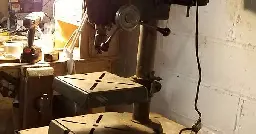
Hi! I’m Jacob, it looks like I’m going to be taking over as mod for this community. It looks like the original intent was to celebrate/talk about repairing stuff/the right to repair stuff, and perhaps the intersection of tech and solarpunk ideals and how to mix them. I’m a big believer in using what we have, including technology, to try to build a better, more environmentally just world (never been one to let the perfect be the enemy of the good). I like fixing things and making them last long past any planned obsolescence or sane expectation of the lifespan of a product.
I thought by way of introduction, I’d share an old project. When my grandfather died, I inherited many of his tools. This drill press belonged to my great grandfather. If I’ve got my understanding of the characteristics right, (three-prong feed lever, this specific chuck) it dates to 1951.
My great grandfather had a… casual relationship with electricity.
Everything still worked great but the wiring worried me. The original cord was non-polarized, not grounded, and the white (red?) wire's insulation had crumbled away basically anywhere I could see it. Great-Grampa had added in a light switch, by slicing back the insulation and cutting one wire, which worked but was unsafe. (Shocks aside, imagine trying to grab that in an emergency, when a piece has gotten away from you and is spinning, or when you’ve got an article of clothing caught in the works).
Luckily the motor's internal wires' insulation looked just fine. The motor has the old fabric-insulated wires, which, ironically, seem to have held up much better than the rubber stuff. I'm glad I didn't have to do anything with the motor internals, a couple rebuild videos have shown me they're a fun mix of overbuilt and delicate from age.
My goal was to overbuild everything, so I rated everything for the motor's power needs and added a grounding wire, weatherproof box, and a tool-grade switch intended for various Powertec power tools.
I had to modify the switch box to fit the new switch, and painted it to match the drill press. I like this because I can slap it into the off position without looking at it.
I love this machine. It’s big, bulky, and weighs a ton, but it’s on its fourth generation of users and I don’t doubt it’ll continue. I love the simplicity of it, the exposed and easily-replaceable belts and motor. I love how easy it is to maintain and fix.
About a year after I finished working on this, I read the book Ecotopia. The book is from the 1970s but it had a section dedicated to the Right to Repair in a society where most tools and appliances are designed with a similar ethos. From “Ecotopian Television and its Wares”:
“Objects that are available in stores seem rather old fashioned. I have seen few Ecotopian-made appliances that would not look pretty primitive on American TV. One excuse I’ve heard is that they are designed for easy repair by users. At any rate they lack the streamlining we’re used to – parts stick out at odd angles, bolts and other fasteners are plainly visible, and sometimes parts are even made of wood. I have, however, observed that Ecotopians do repair their own things. In fact there are no repair shops on the streets. A curious corollary is that guarantees don’t seem to exist at all. People take it for granted that manufactured items will be sturdy, durable, and self-fixable – which of course means they are also relatively unsophisticated compared to ours. This state of affairs has not been achieved easily; I have heard many funny stories about ridiculous designs produced in the early days, lawsuits against their manufacturers, and other tribulations. One law now in effect requires that pilot models of new devices must be given to a public panel of ten ordinary people (‘consumers’ is not a term used in polite conversation here). Only if they all find they can fix likely breakdowns with ordinary tools is manufacture permitted.”
While reading the vintage machinery forums, I came across a more succinct quote: 'These old tools don't break, they're just missing parts.'
I think that's a really nice way of looking at it.
- Crypto Commons Association - SolarPunk WOW Eventgitcoin.co Crypto Commons Association - SolarPunk WOW! Event 8-14 october | Grants
First things first, we’d like to thank everyone who supported us through Gitcoin Grants until now. Your help has been of great encouragement. Thank you for supporting the crypto commons! ❤️ We are participating to Gitcoin Grants 15 to get support in making our ReFi event SolarPunk WOW (8-14th octob...
> The event will consist of workshops and panels on regeneration and ReFi to foster the movement forward, and a hackathon to ideate and build SolarPunk tech in the Crypto Commons Hub!
- A cyber-physical permaculture garden
- A plastic recycling machine
- Solar panels



